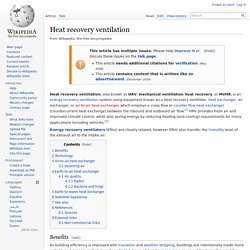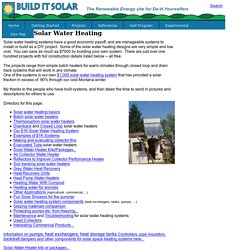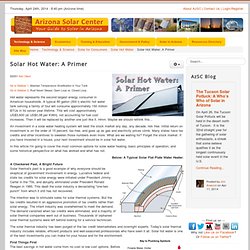

Modern Hydronic Heating: For Residential and Light Commercial Buildings - John Siegenthaler. Hot Water Piping Systems- Buda, Texas. How to Maintain Hot Water Heating Systems. Hot water heating systems need a little maintenance, like venting the radiators and draining the boiler, to keep things running efficiently.

Gravity and hot water furnaces are not often installed in new homes today, but similar systems with the old cast-iron radiators throughout the house were fixtures in homes built around 1900, and some of them are still working. Clanking, popping, and gurgling as they swing into action whenever the thermostat detects room temperatures dropping, they provide a relatively steady flow of heat without the drafts you get in forced-air furnaces. Hot water systems are closed, meaning that the water constantly circulates through the pipes and into the boiler.
Newer units have many zones with two water pipes linked to each zone: one circulating heated water to the rooms and the other returning the much cooler water back to the boiler to get reheated. To maintain a system, you should lubricate the circulating pump motor. How to Maintain Hot Water Heating Systems. The Unico System. Heat recovery ventilation. Energy recovery ventilators (ERVs) are closely related, however ERVs also transfer the humidity level of the exhaust air to the intake air.

Benefits[edit] As building efficiency is improved with insulation and weather stripping, buildings are intentionally made more airtight, and consequently less well ventilated. Since all buildings require a source of fresh air, the need for HRVs has become obvious. While opening a window does provide ventilation, the building's heat and humidity will then be lost in the winter and gained in the summer, both of which are undesirable for the indoor climate and for energy efficiency, since the building's HVAC systems must compensate.
HRV introduces fresh air to a building and improves climate control, whilst promoting efficient energy use. UK building regulations require one air change every two hours (0.5 ACH). Technology[edit] 7 Solar Water Heating System Designs by Michael Hackleman. (Rob Harlan is a general and solar contractor with 25 years of experience with solar water heating systems in Mendocino County, California.

Rob primarily designs and installs photovoltaic systems today.) MH: Rob, will you give a brief history of the last 30 years of solar-water heating system design and implementation? Rob: Solar-water heating systems got a real boost in the 1970s when tax credits were offered by state and federal programs to help folks make the investment. These systems were intended primarily for domestic hot water, i.e., showers, dishwashing, cooking, and clotheswashing.
They were also popular for heating the water in pools and hot tubs. MH: As I recall, a lot of manufacturers also disappeared when the tax credits went away. Rob: Some designs were indeed flawed—poorly implemented, overly complex, or incorporating untested ideas. History Of Solar Water Heaters. Plans For Various Passive Solar Heaters. The Do It Yourself Passive Solar Window Heater How To Make A Passive Solar Heater.

This is a very simple and inexpensive project. There are many passive solar heating projects out there, but we must admit, we were very sceptical at first. In the cold November mornings, what help can a simple bit of styrofoam and aluminum foil really provide? So we decided to make one and see how well it works. How this works: When the sun shines, the black painted area will absorb the heat from the suns rays. Solar Water Heating Projects and Plans. Solar water heating systems have a good economic payoff, and are manageable systems to install or build as a DIY project.

Some of the solar water heating designs are very simple and low cost. You can save as much as $7000 by building your own system. There are just over one hundred projects with full construction details listed below -- all free. The projects range from simple batch heaters for warm climates through closed loop and drain back systems that will work in any climate. One of the systems is our own $1,000 solar water heating system that has provided a solar fraction in excess of 90% through our cold Montana winter. My thanks to the people who have built systems, and then taken the time to send in pictures and descriptions for others to use. Directory for this page: Book: The Integral Passive Solar Water Heater.
A Solar Hot Water Primer - Ken Olson. ©2001 Ken OlsonThis email address is being protected from spambots.

You need JavaScript enabled to view it. Go to Sidebar 1, Maintain Temperature Stratification in Your Tank Go to Sidebar 2, Rust Never Sleeps: Open Loop vs. Closed Loop Hot water represents the second largest energy consumer in American households. A typical 80 gallon (300 l) electric hot water tank serving a family of four will consume approximately 150 million BTUs in its seven year lifetime.
An investment in a solar water heating system will beat the stock market any day, any decade, risk free. In this article I'm going to cover the most common options for solar water heating, basic principles of operation, and some historical perspective on what has worked and what has not. Below: A Typical Solar Flat Plate Water Heater. A Checkered Past, A Bright Future Solar thermal's past is a good example of why everyone should be skeptical of government involvement in energy.
Turn the thermostat down. Caution! Heating Home Underfloor heating, Heating system, Electric Underfloor heating, Heating system - Radiant Floor Heating. Radiant Floor Heating - Radiant Floor Heating, Underfloor Heating, Radiant Ceiling Heating, In Slab Heating - CBS Radiant Heating Systems. Radiant Floor Heating: Safe-t-FLEX Heating Foil Safe-t-FLEX cabron film heating roll Safe-t-FLEX: The ultimate radiant floor heating solution and underfloor heating technology.
Radiant Floor Heating is the new, easy, way to install comfortable underfloor heating. Safe-t-FLEX is a new type of thin electric heating foil - just 0.3 mm - with a unique design that makes it very easy to install. The thermal conductive carbon ink material, is designed in a parallel strip pattern to enable the foil to be cut every ten mm, this allows exact fitting of the floor area. The radiant floor heating foil is dispatched in a roll ready for "on site cutting to size", slim crimp connectors are used for attaching the wires. Speedheat Floor Heating Australia - Floor Heating Home.